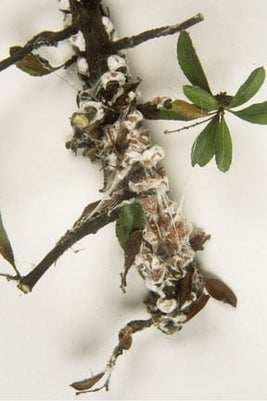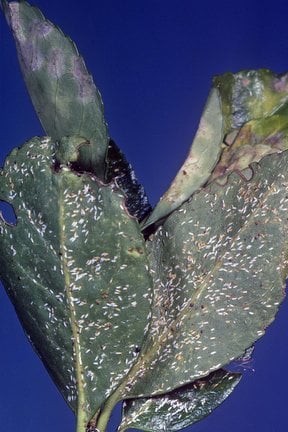
Quick facts
Common name - Woolly vine or currant scale
Scientific name - Pulvinaria vitis
Plants affected - A wide range including grape vine, peach, nectarine, currants, gooseberry and pyracantha
Main symptoms - White egg masses, honeydew and sooty mould
Caused by - Sap sucking scale insects
Timing - Spring and summer
What is woolly vine or currant scale?
Scale insects are sucking true bugs belonging to several families in the Hemiptera. Typically the adults are immobile having a flattened or raised appearance, with no visible legs. They often look like a ‘scale’ on a leaf or stem, many species produce a white wax often covering egg masses. There are more than 100 species found in Britain, 26 of which have been introduced. More than 25 species can be found in gardens or on houseplants.
Adult females of this species mature in September or October, they are 5-7 mm long dark brown and convex, immobile and attached to host plants stems. The adult male is winged and pinkish, at only 1.5 mm long it is rarely seen. Males die after mating but the females overwinter and produce white waxy egg masses in May or June. The egg masses are usually only found on stems and the wax can be pulled out in long threads; these characteristics distinguish this species from other insects that produce white waxy coverings such as cushion scale , fluted scale , horse chestnut scale , woolly aphid and mealybug .
The eggs hatch in June-early July initially the nymphs (crawlers) are mobile before eventually settling down on one year old wood to complete their development.
Symptoms
Large populations of woolly vine or currant scale can leave heavy deposits of sticky honeydew upon which a black non-parasitic fungus sooty mould often grows. Affected plants may also lack of vigour.
The 5-7 mm dark brown insects will be evident upon examination on stems and in spring white waxy egg masses are usually clearly visible.
Management
- Where possible tolerate populations of scale insects. Well-tended healthy plants are able to tolerate light populations of these insects and so they do not necessarily require management
- Encourage predators in the garden, some ladybirds , parasitoid wasps and some birds will eat scale insects
- Adult scales and egg masses can be removed when seen but this may not reduce large populations
- It can be worth considering replacing heavily affected plants





















